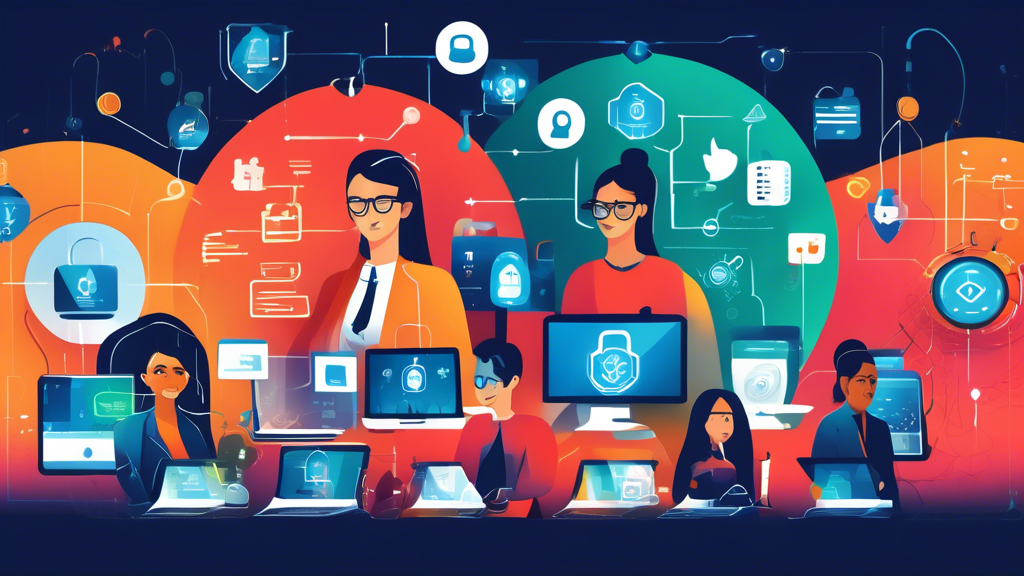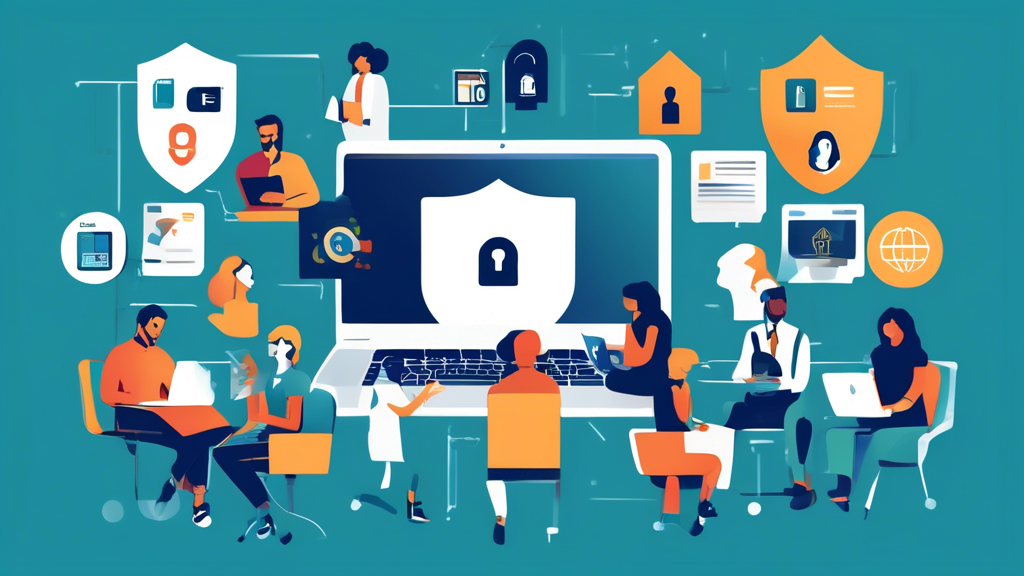Introduction
In today’s digitally-driven world, safeguarding personal and professional data is more critical than ever. Data protection online has emerged as a top priority for individuals and organizations alike, as the consequences of inadequate data security can be dire. From financial loss to legal repercussions, the implications of failing to protect sensitive information can extend far beyond the digital realm.
This comprehensive guide will delve into essential strategies for data protection online, encompassing the significance of data security, best practices to enhance protection, and the advanced technologies revolutionizing cybersecurity. By employing these strategies, you can bolster your defenses against ever-evolving cyber threats and ensure the integrity of your valuable data.
Understanding the Importance of Data Protection Online
Why Data Protection Online is Crucial in the Digital Age
In today’s digital age, safeguarding personal and organizational data has become more critical than ever. The acceleration of online activities—from e-commerce to remote work—has dramatically increased the volume of sensitive information being transmitted across the internet. This surge necessitates robust data protection measures to ensure that private data is safeguarded against unauthorized access and cyber threats.
Data protection online serves as the backbone for maintaining user trust and organizational credibility. It ensures the privacy and security of personal information such as passwords, financial details, and sensitive communications. The failure to prioritize data protection can lead to severe consequences, including the potential loss of valuable data, reputational damage, and legal repercussions.
The Rising Threats: Cyberattacks, Data Breaches, and Identity Theft
The landscape of cyber threats is continually evolving, posing significant challenges to data protection online. Cyberattacks, including phishing scams, malware, and ransomware, have become rampant, targeting both individuals and organizations. These attacks aim to infiltrate systems, steal valuable information, and often demand hefty ransoms.
Data breaches are another critical threat, with cybercriminals exploiting vulnerabilities in security systems to access vast amounts of personal and financial information. Prominent cases of data breaches have resulted in the exposure of millions of records, causing substantial financial losses and long-term damage to affected entities.
Identity theft, a direct consequence of inadequate data protection, can have devastating effects on individuals, leading to financial fraud, unauthorized transactions, and a compromised digital presence. In an interconnected world, the implications of identity theft extend beyond personal harm, potentially affecting professional lives and relationships.
Legal and Financial Implications of Inadequate Data Protection
Neglecting data protection online doesn’t just pose a risk to privacy—it can also lead to significant legal and financial ramifications. Legislation such as the General Data Protection Regulation (GDPR) in the European Union and the California Consumer Privacy Act (CCPA) in the United States impose stringent requirements on how companies handle personal data. Non-compliance with these regulations can result in hefty fines and legal actions.
Financially, the costs associated with data breaches and cyberattacks are staggering. Organizations can face direct costs, including legal fees, settlements, and regulatory fines, as well as indirect costs related to reputational damage, loss of customer trust, and operational disruptions. The financial impact often extends long-term, impeding business continuity and growth.
Moreover, investing in data protection online can be more cost-effective compared to the expenses incurred due to security breaches. Proactive measures such as robust cybersecurity protocols, employee training, and regular risk assessments can mitigate potential threats and provide a stronger defensive framework.
In conclusion, understanding the importance of data protection online is the first step toward a secure digital environment. Recognizing the escalating threats and staying informed about evolving cybersecurity practices are crucial for safeguarding sensitive information and ensuring compliance with regulatory standards. Prioritizing data protection not only secures personal and organizational data but also builds a resilient and trustworthy digital presence.
Best Practices for Effective Data Protection Online
Implementing Strong Password Policies and Multi-Factor Authentication
One of the cornerstone practices for ensuring data protection online is the implementation of strong password policies. Weak passwords are one of the most common entry points for cybercriminals. A robust password should include a mix of upper and lowercase letters, numbers, and special characters, and it should be at least twelve characters long. Additionally, users should avoid using easily guessable information, such as birthdays or common words.
To further enhance data security, businesses should adopt multi-factor authentication (MFA). MFA adds an extra layer of protection by requiring users to provide two or more verification factors to gain access to a resource such as an application, online account, or VPN. Common verification methods include passwords, text message codes, and biometric verifications like fingerprints or facial recognition. By combining multiple forms of authentication, MFA significantly reduces the risk of unauthorized access.
Regular Software Updates and Patch Management
Keeping software up-to-date is another critical aspect of data protection online. Software developers routinely release updates to fix vulnerabilities and improve functionality. Failure to install these updates can leave systems exposed to cyber threats. Organizations should establish a regular schedule for software updates and patch management, ensuring all applications and operating systems are current.
Patch management involves the process of managing a network of computers by regularly performing patch deployment tasks to keep systems secure. This not only includes operating systems and application patches but also firmware updates on hardware devices. Automated tools can help manage this process efficiently, reducing the chances of human error and ensuring timely application of patches.
Utilizing Encrypted Connections: VPNs, SSL/TLS Protocols
Encrypting connections is a fundamental practice for safeguarding data transmitted over the internet. Virtual Private Networks (VPNs) and SSL/TLS protocols are essential tools for achieving this.
A VPN encrypts the data transmitted between a user’s device and the internet, making it difficult for cybercriminals to intercept and read the information. Using a VPN is particularly crucial when accessing public Wi-Fi networks, which are often less secure and more vulnerable to attacks. By masking the user’s IP address and encrypting all data exchanges, a VPN provides a safer online browsing experience.
SSL (Secure Sockets Layer) and its successor TLS (Transport Layer Security) are cryptographic protocols designed to provide secure communication over a computer network. Websites that implement SSL/TLS protocols ensure that any data exchanged between the user’s browser and the web server is encrypted, protecting sensitive information such as login credentials, financial information, and personal data.
For websites, deploying an SSL certificate helps build trust with visitors. Not only does it enhance data protection online, but it also improves search engine rankings, as SEO algorithms favor sites with encrypted connections. In this way, data protection measures also contribute to better overall website performance.
By consistently applying these best practices, individuals and organizations can significantly improve their data protection online, mitigating risks and securing sensitive information from various forms of cyber threats. Ensuring strong password policies, regular software updates, and encrypted connections will create a robust foundation for a secure digital presence.
Leveraging Advanced Technologies for Superior Data Protection Online
The Role of Artificial Intelligence and Machine Learning in Cybersecurity
With the increasing sophistication of cyber threats, traditional security measures are often insufficient to protect sensitive information. Artificial Intelligence (AI) and Machine Learning (ML) are revolutionizing the field of cybersecurity by offering proactive defense mechanisms. These technologies analyze vast amounts of data in real-time to detect anomalies and predict potential cyber threats before they occur. This predictive capability significantly enhances data protection online, as it allows for the early identification and neutralization of threats.
AI-driven security systems can adapt to new and evolving threats more efficiently than conventional methods. Through continuous learning and adaptation, these systems can identify new patterns of malicious behavior that may go unnoticed by human analysts. For example, AI can differentiate between normal user behavior and suspicious activities, flagging possible security breaches while minimizing false positives. This level of precision is critical for maintaining robust data protection online, especially in large-scale and dynamic environments.
Blockchain Technology for Robust Data Integrity
Blockchain technology offers a groundbreaking approach to ensuring data integrity and security. Known primarily for its use in cryptocurrencies, blockchain’s decentralized, immutable ledger system makes it an excellent tool for securing data transactions. Each block in a blockchain contains a cryptographic hash of the previous block, a timestamp, and transaction data, which collectively form a chain that is resistant to modification.
By leveraging blockchain technology, organizations can achieve unmatched data protection online. The decentralized nature of blockchain eliminates the single point of failure—a common vulnerability in traditional data storage systems. Moreover, any attempt to alter data in a blockchain is immediately detectable, as it would require altering all subsequent blocks, something that is computationally impractical.
Blockchain also brings transparency and accountability to data transactions. Each transaction is traceable and verifiable, ensuring that all parties involved can trust the integrity of the data. This is particularly beneficial in industries that handle highly sensitive information, such as finance, healthcare, and supply chain management. By embedding blockchain into their data protection strategies, organizations can significantly enhance the security and reliability of their data management systems.
Cloud Security Solutions: Benefits and Best Practices
The adoption of cloud computing offers numerous advantages for businesses, including scalability, cost efficiency, and flexibility. However, moving data to the cloud introduces new security challenges that must be addressed to ensure comprehensive data protection online. Cloud security solutions are essential for safeguarding data stored and processed in cloud environments.
One of the primary benefits of cloud security is the ability to employ advanced security measures that are often beyond the reach of individual organizations. Cloud service providers deploy robust security protocols, including encryption, intrusion detection systems, and continuous monitoring to secure their infrastructure. However, it is crucial for organizations to implement best practices to maximize the security benefits offered by cloud services.
Firstly, organizations should choose reputable cloud service providers that comply with industry standards and certifications. Ensuring that the provider adheres to rigorous security protocols is foundational for maintaining data protection online. Secondly, data encryption should be a priority. Encrypting data both at rest and in transit ensures that even if data is intercepted, it remains unintelligible to unauthorized parties.
Another critical practice is the implementation of access controls and identity management systems. Limiting access to sensitive data based on user roles and responsibilities minimizes the risk of internal threats. Multi-factor authentication (MFA) and robust password policies add additional layers of security, making it more challenging for cybercriminals to gain unauthorized access.
Regular audits and compliance checks are also essential. Continuous monitoring and regular security assessments help identify vulnerabilities and ensure that security measures remain effective against evolving threats. By integrating these best practices, organizations can leverage cloud security solutions to enhance their data protection online, ensuring their data remains secure and accessible under any circumstances.
In conclusion, leveraging advanced technologies like AI, blockchain, and cloud security solutions is pivotal for achieving superior data protection online. As cyber threats continue to grow in complexity and frequency, staying ahead with innovative security measures is essential for safeguarding sensitive information. By adopting these advanced technologies and best practices, organizations can build a resilient cybersecurity posture that not only protects their data but also fosters trust and reliability in the digital age.
Conclusion
In the dynamic landscape of the digital age, data protection online has never been more vital. As the prevalence of cyberattacks, data breaches, and identity theft continues to rise, understanding the importance and implementing robust data protection strategies is crucial. Ensuring strong password policies, employing multi-factor authentication, and keeping software updated are fundamental practices that can significantly bolster your online security.
Additionally, the use of encrypted connections and advanced technologies such as artificial intelligence, machine learning, and blockchain can further reinforce your data protection framework. Embracing these modern solutions, alongside cloud security best practices, can provide an additional layer of defense against evolving cyber threats.
By prioritizing data protection online, individuals and organizations can safeguard sensitive information, mitigate potential legal and financial repercussions, and maintain the trust of their users. The ever-changing nature of digital threats highlights the need for continuous vigilance and adaptation of security measures to ensure a secure and resilient online environment.









